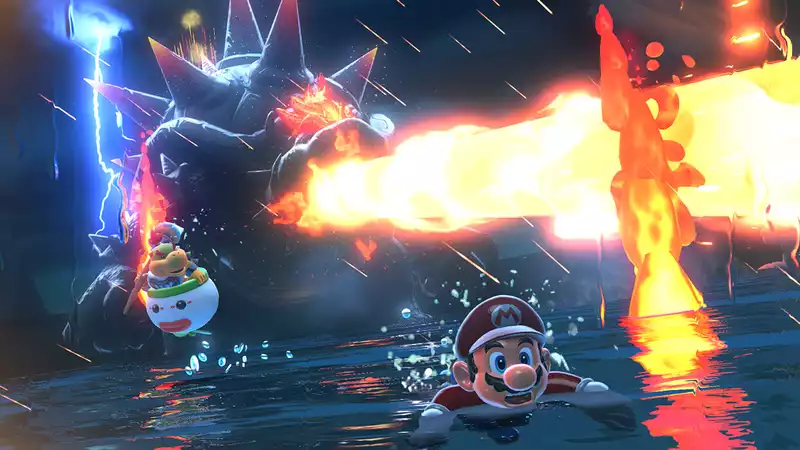With the release of Super Mario 3D World on the Nintendo Switch, few games from the Wii U library have been ported to Nintendo's handheld console hybrid Unlike past Wii U ports, however, Nintendo decided that the $60 offering price needed to be enhanced by the inclusion of a gameplay expansion titled "Bowser's Wrath"
This is an odd bundle given that "Bowser's Wrath" bears no resemblance to "3D World" Nintendo has combined two games that are, for all intents and purposes, completely different into one package We can only speculate on the reason for this, but one rationale could be to offer a more affordable game to attract fans who already have the game on the Wii U Or perhaps Nintendo is trying to gauge the reaction to the new approach to open design in "Bowser's Wrath," which expands on the structure of "Super Mario 64," "Sunshine" and "Odyssey"
Whatever the reason, one thing is certain: the ambitions of "Bowser's Wrath" are too much for the Nvidia Tegra X1 chip in the Switch We'd love to see what a more advanced Nintendo Switch Pro could do with such a title, even if it doesn't appear anytime soon
John Linneman of Digital Foundry has an excellent technical breakdown of Bowser's Wrath His analysis shows that the game runs between 720p and 792p, indicating that the open-world design stretches the Switch's hardware, since in "Bowser's Fury," Mario can move to any play area without moving to another world, part of the asset must always be present when panning the camera
Linneman found a graphic effect where sub-pixels seem to shimmer in the distance The pixels appear to be popping out It is also likely that the game employs techniques seen in 2017's Super Mario Odyssey to maintain a steady 60 fps, such as lowering the frame rate of distant objects and replacing 3D models with 2D models
Looking at Mario himself, he is not as smoothly rounded as one might expect Due to the low resolution, "bumps" in the pixels can be seen, making Mario look more blocky Perhaps there is a layer of anti-aliasing to smooth out the jagged edges, but these artifacts occur when a 720p image is enlarged on a 4K display
Weak hardware means that Nintendo is forced to use older types of effects that existed in the PS3 generation I am not a game developer, nor am I a computer graphics expert, but the basic reflection mapping that appears on Mario's hat and clothes when he gets wet lacks the realism of more modern games The original "Uncharted" used similar effects: the PS3 release "Uncharted - Atlantis in the Desert" had a similar effect When Nathan Drake jumped into a pool of water, his clothes were almost plastic-like veneer, simulating the appearance of damp cloth; impressive for 2007, but lacking when compared to modern technology
Nevertheless, in a cartoonish game like "Bowser's Wrath," it's nice to have some detail to begin with Also, given the game's art style, it is far less incongruous However, this points to the techniques that Nintendo's artists and engineers must rely on with the tools at their disposal
That is not to say that this game is ugly by any means There are plenty of objects to play with, colorful characters and kittens, and subtle artistic cues Nevertheless, for videophiles who have gotten LG OLED TVs and have grown accustomed to playing games in 4K resolution, one can't help but wonder what "Bowser's Wrath" would look like if it were running on more powerful hardware
For the record, a 720p image is a little over 900,000 pixels; a full 1080p image is over 2 million; having to stretch 900,000 pixels to over 82 million on a 4K display is nothing short of spectacular
Still, one can't help but imagine what "Bowser's Wrath" would look like if it ran on hardware half as powerful as the PS5 The 1440p image from the checkerboard rendering will look brilliant on a 4K display Fortunately, with the help of emulation, we can see how the latest Mario game looks in 4K: with the Wii U emulator, we can play Super Mario 3D World in 4K on a PC The emulation is not perfect, and while there is a drop in frame rate, the sharpness and fidelity are quite clean
Mario games tend to use simple, bright colors, but given Nintendo's imaginative designs, it is highly likely that artists saw some benefit from implementing HDR Currently, the Switch's color depth is 8 bits, meaning it can output 16 million colors; HDR is 10 bits, bumping the number of available colors to over 2 billion This increases color depth and detail, bringing more realistic gradations and transparency to the image For lack of a better word, it makes the images "pop" In my opinion, if you see Mario in HDR, you will be visually amazed
At this time, Nintendo has no immediate plans to release the Switch Pro The system remains in high demand and the Covid-19 pandemic has created a shortage of parts, which will make ordering from manufacturers more expensive and difficult as multiple companies vie for parts
While the SwitchPro remains a fleeting hope, the hope of seeing Nintendo software push its graphical possibilities lives on










Comments